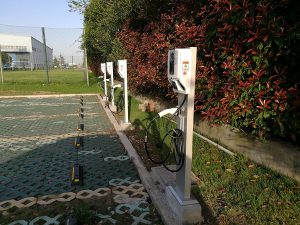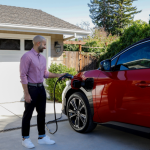Installing an EV charger in Europe involves following local standards, regulations, and best practices. European home and public chargers generally use the Type 2 (Mennekes) connector for AC charging. Type 2 supports both single-phase and three-phase power, which means European home chargers can range from 3.7 kW (16 A single-phase) to 11 kW (16 A three-phase) or even 22 kW (32 A three-phase). For example, many EU homes have 230 V single-phase supply, so common wallboxes there provide 7–11 kW. In contrast, public Level 2 chargers often deliver 22 kW (single-phase) or 43 kW (three-phase) in commercial parking. For fast charging, CCS2 (Combined Charging System) is the prevalent DC standard in Europe; CHAdeMO is mostly phased out for new stations.

In practice, installing a charger begins with planning. Determine the ideal location (ideally near your electrical panel) and check that your home’s wiring can support the load. In most EU countries, a dedicated circuit with a dedicated residual-current (RCD) protection is required. If you live in an apartment or multi-unit dwelling, ensure your building management permits installation and identifies the parking spot. All European EV chargers (especially outdoor ones) should have an appropriate weatherproof rating (IP44 or higher). As one guide notes, most Level 2 chargers are built for outdoor use, but installers often hardwire them and seal all enclosures to ensure a watertight installation.
European countries have varying rules on who can install EV chargers, but the safest approach is to use a qualified electrician or certified installer. They will handle mounting the charger (wall or pedestal), running conduit, and connecting to the distribution board. In some countries, you will need to notify the local grid operator or schedule an inspection before turning the charger on.
Regulations and Incentives
Europe has been updating laws to expand charging infrastructure. Under the EU’s Energy Performance of Buildings Directive (EPBD), all EU member states must require that new buildings and major renovations include EV charging infrastructure. For instance, new commercial buildings with 6–20 parking spots must have one charger per 5 spots (or pre-cabling in 50% of spots). From January 2025, non-residential buildings with over 20 spaces must have at least one charger for every 10 spaces (or equivalent cabling). This means many apartment complexes and workplaces will need chargers soon.
Several countries also offer grants and tax incentives for EV chargers. For example, France has industrial “bonus écologique” for e-mobility infrastructure, Germany’s KfW program funded charging stations, and the UK’s (OZEV) grants support workplace and street charging. (Note: UK home charger grants ended in 2022, but some tax deductions may apply.) In general, check your country’s transport or energy ministry website for current programs. Despite regional differences, the trend is clear: governments encourage EV charger installation through financial support.
Installation Steps
-
Assess Power Supply: Verify your electrical panel capacity. Most home chargers require a 16–32 A 240–400 V circuit (1- or 3-phase). Some homeowners may need a panel upgrade or meter adjustment.
-
Obtain Permits: Depending on local rules, you might need a building permit or electrical inspection. In many EU countries, certified electricians handle paperwork.
-
Mount the Charger: Fix the charger to a wall or pedestal near the parking area. Make sure the cable can easily reach the car’s inlet. Provide protective bollards if needed to guard the charger from vehicles.
-
Connect and Protect: Run cabling from the panel to the charger. Install a dedicated circuit breaker and an RCD (FI) or RCBO for ground-fault protection. Connect according to the charger’s manual (single or three-phase wiring). In outdoor setups, keep all connections inside a weatherproof enclosure.
-
Test and Commission: After installation, test the charger with an EV. Check that it powers on, communicates (if networked), and charges correctly. Retain any safety certificates.
Following manufacturer instructions and local electrical codes is essential. Many installers recommend hardwiring outdoor chargers rather than using a plug, to prevent water entry around the plug. The end result should be a safe, reliable charging station that meets all regional standards.
Safety and Maintenance Tips
-
Weatherproofing: Ensure outdoor chargers have adequate IP protection (IP54 or better). For example, choosing an enclosure rated 4 or 4X helps resist rain, dust and corrosion.
-
Regular Inspection: Periodically check cables for wear, and clean the connector. Make sure the RCD test button works.
-
Firmware Updates: If your charger is “smart,” apply software updates when available to improve security and performance.
-
Secure Access: If on a shared property, use user authentication or a tethered cable lock to prevent unauthorized use.
-
Energy Management: Consider load balancing if you have multiple chargers or high-demand appliances. Some chargers can coordinate to avoid overloading your home supply.
By following these guidelines and complying with EU rules, you can install an EV charging point safely and effectively. A properly installed charger will provide reliable service for years, helping you and others embrace electric mobility.

